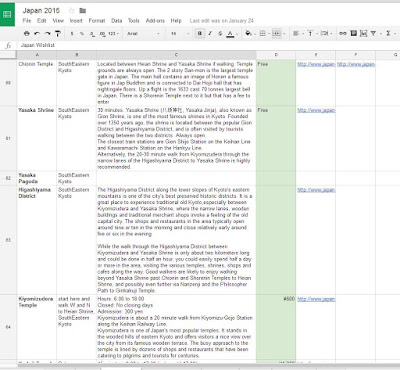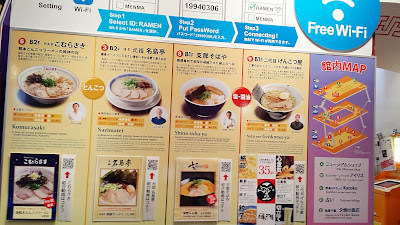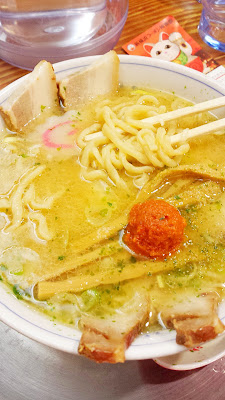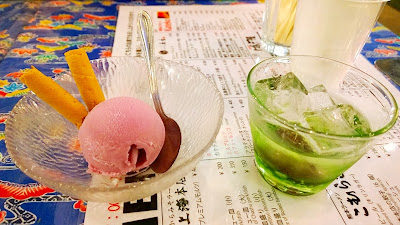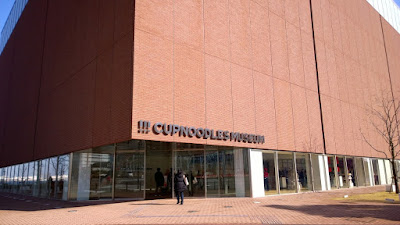For Travel Tuesday in Japan this time, I want to take a break from the sightseeing and let’s talk about some Kyoto food! As I mentioned, Kyoto served as the capital for Japan for about 1000 years, so has a culinary lineage that includes royalty and imperial court, as well as the base for literally thousands of temples and shrines in the area. Famous kinds of foodie goals to seek out while in Kyoto include
- Kaiseki, elaborate haute multi-course traditional Japanese dinners
- Shojin Ryori, Japanese Buddhist vegetarian cuisine
- Tofu
- Sake
I have already shared with you how I enjoyed a kaiseki dinner and breakfast when I stayed at a ryokan by Mount Fuji. You can see a great breakdown of what are the kinds of foods you would see in a kaiseki here at Japan Guide and Japan Talk.
And I showed you a Zen vegetarian shojin ryori lunch at Shigetsu restaurant at Tenryu-ji Temple at Arashiyama.
But, did you also know that the waters in Kyoto are reknown for how clear and pure its waters are, and some byproducts of utilizing that perfect water are Tofu and Sake? In fact, Tofu is considered a local specialty in Kyoto, might be considered the best in Japan, and is popular enough to be Tofu Ryori (“tofu cuisine”).
Tofu is everywhere – and it’s really tasty. I discovered I’m in love with yuba (tofu skin). In fact the common availability of Kyoto tofu is one of the reasons F found Kyoto to be his favorite destination of all the places we visited in Japan during our 2 week trip. If you are vegetarian, even vegan, you are going to get along well in Kyoto.
Yudofu
During our visits to Kyoto temples and shrines, we stopped at a restaurant just below stage at Kiyomizudera by Otawa Waterfall’s 3 streams for a late breakfast and fueling of Yudofu. Yudofu is a hot soybean curd- it was a bargain for 2 people at 800 yen I thought. You carefully remove a piece from the hot water with light flavoring, and then in your own individual bowl add condiments like green onion or sauce (you can see the sauce container is placed in part of the yudofu wooden bath). Simple perfection.
It’s hard to describe what it could be comparable to – the tofu is solid but soft, almost the texture of big dumplings in being solid yet soft, and absorbing the flavors in the bowl while offering its own clean freshness.
Tofu with Beer
We went to a craft beer bar called Beer Komachi that along with their local Kyoto and Japanese brews and a few imports also offered an izakaya food menu that included vegetarian friendly options including tofu options of Tofu Pizza (which F ordered twice during our visit it was so good). I was taken aback how how great Yuba soy milk skin goes with beer, and it’s fresh creaminess was surprisingly reminiscent of burrata!

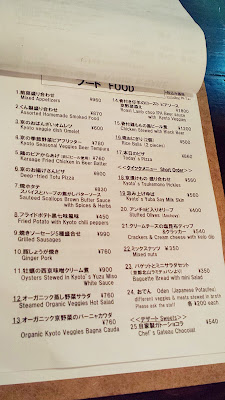


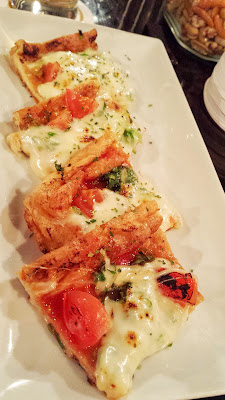

Tofu Kaiseki at Tousuiro
There is one restaurant that specializes in Tofu Kaiseki in Kyoto called Tousuiro – it has two locations, and it turns out the one in Gion was essentially just a block away from our AirBnB. So I had F ask a colleague who can speak Japanese to call and make a reservation for us, ensuring that at least his dinner would really be completely vegetarian – my version could include seafood. Here’s a look at our experience to Tousuiro
We ordered local Kyoto sake to enjoy with our dinner.
When we arrived, we removed our shoes and were seated at a chef’s bar that thankfully had sunken seating (Zashiki) so although we were on the floor I didn’t have to sit awkwardly in my dress and could stretch my legs in the sunken floor. Sitting at the bar meant we got to watch the chef prepare everything, though we didn’t really talk because I don’t think he spoke much English. Our only communications was to express with gestures how beautiful and delicious everything we had was.
Even looking back at these photos, I am a little teary eyed at how achingly exquisite this meal was. I didn’t want to be obnoxious with my camera so was trying to take them quickly and also eat at a good pace as I think we were among the last seating for the evening. But I hated destroying by eating the stunning art before me, even though I knew that was its purpose. Ha such mixed feelings…
First course
This is the “can have seafood” version I ate
This is the vegetarian version
Second Course
Yudofu. We ate the same thing, but had different sauces to add to the tofu. The chef said we could get this refilled as many times as we wanted. We had him refill it once, but were afraid to do any more or we wouldn’t be able to eat the other courses though we didn’t know what was coming yet…
Third Course
Soup- my version that can include seafood, and his that is completely vegetarian. I think his was better.
Fourth Course
I had been tortured by the scent of the chargrilled tofu for a while, and was so stoked when it finally arrived. His version didn’t have the shrimp on the plate but was otherwise the same. It was sooo good, one of my top two favorite dishes of the night with the smoky sweetness from the grill and miso sauce that has carmelized.
Fifth Course
This is the “can have seafood” version I ate
This is the vegetarian version
Sixth Course
I always love how gorgeous and elegant the bowls are and then the surprise when you open it to reveal what’s inside! This is the “can have seafood” version I ate
This is the vegetarian version
Seventh Course
I was super jealous of his vegetarian course with the yuba.
This is the “can have seafood” version I ate
Eighth Course
Dessert!
If you think you don’t like tofu – I would suggest that perhaps you haven’t really tried high quality, fresh tofu yet. The difference between the tofu that I made faces at when I first started dating F and was trying to figure out which plastic packaged in water kind to get at Whole Foods and how now I mainly get my fresh tofu at Bui Tofu (best tofu in Portland I think) is vast – sort of like the difference between frozen microwavable burgers and the best burgers in town like at Toro Bravo or Little Bird (my current faves). It’s like American cheese vs real aged cheeses.
There are many preparations of tofu out there – some almost disguise it such as in Chinese MaPo Tofu or Korean SoonDuBu Jjigae with so much spice. What I really love about the Japanese treatments you see here is that they keep it simple and let you really taste the tofu’s clean flavors that can be creamy like with yuba, smokey and sweet like with the grilled skewers, silky yet firm like in yudofo, or solid enough to be a vehicle for toppings with tofu pizza. You just have to find what fits you.
I would go to Kyoto again in a heartbeat, and definitely seek out tofu again. Did any of these dishes intrigue you, would you try any of them? Did you know tofu was such a specialty in Kyoto?
Here’s a summary of my Japan Travel post series:
- Guide to Planning a Trip: Research
- Guide to Planning a Trip: Mapping
- Hagoita Ichi Winter Festival at Sensoji Temple, Japan
- Japanese Treats at Temples and Shrines
- Winter Illuminations in Tokyo (Winter Season – November – February!)
- Snow Monkeys in Hot Springs
- Onsen by Mount Fuji covers Onsen 101 and how we loved our stay at Lake Kawaguchiko
- Dining at a Ryokan a look at what a traditional dinner and breakfast might be during a ryokan stay
- Visiting Cup Noodles Museum in Yokohama (just outside Tokyo)
- Visiting Shin Yokohama Ramen Museum
- Kyoto Temples and Shrines (walking tour starting in Higashimaya with stops especially at Kiyomizudera Temple, Kodaji Temple, Heian Shrine)
- Kyoto Temples in Arashiyama
- Kyoto Tofu
- Kyoto Famous Sights of the Kinkakuji (The Golden Pavilion) and Fushimi Inari (Red Torii Gates)
- Famous Signs of Osaka and eating Osaka Food specialities like okonomiyaki, takoyaki and kushikatsu
- Visiting Himeji Castle, the famous white castle in Japan
- Fun at Japanese Cafes and More including Maid Cafe, Cat Cafe; theme parks of J World and Namja Town, a geeky stop at Kanda Myojin, and Ghibli Museum
- Japan Eating Checklist is my top 25 list of things to try to include as an eating experience when visiting Japan
- New Year’s in Japan: Oji Fox Parade, and some photos of a Meiji Shrine visit on New Year’s Day











